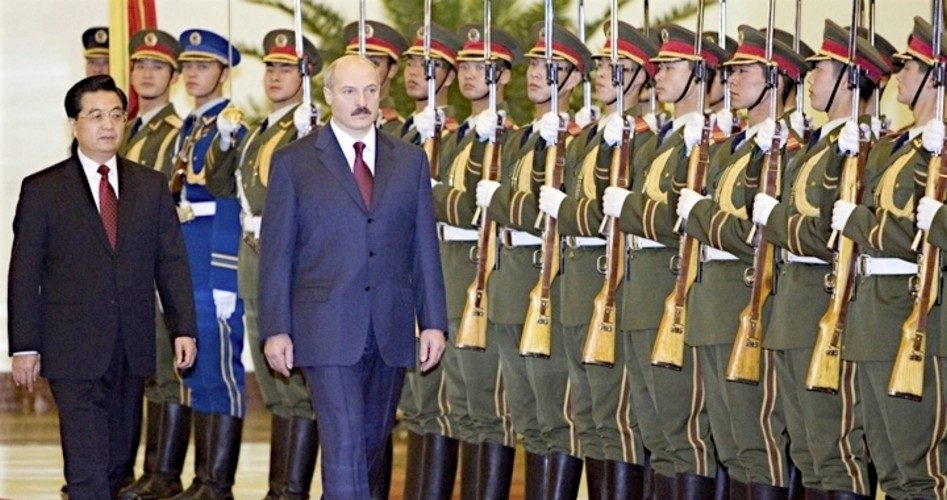
Europe’s last dictatorship may soon go nuclear as it announces major construction of its first nuclear power plant while at the same time it is apparently aiding Communist China with its mobile launchers for intercontinental ballistic missiles.
On Thursday, September 13, the Russian-based engineering company Atomenergoproyekt told the Belarusian Telegraph Agency (BelTA) that it will commence major construction on Belarus’s first and only nuclear power plant on June 15, 2013.
On Wednesday, a day before the announcement, a meeting of the sixth operational group on the nuclear power plant project was held and led by Belarus’s First Deputy Prime Minister Vladimir Semashko.
Additional representatives of the “Belarusian government, NPP construction directorate (customer), the united company NIAEP-Atomstroyexport (the general designer of the power plant and the general contractor), Belarusian subcontractors, and the Grodno Oblast administration,” were also present at the meeting, according to BelTA.
The construction site of the proposed power plant was examined by officials prior to their meeting. Excavation and work on the foundation is already well under way. Builders are scheduled to have the bed drainage completed by November 20. This drainage will “simultaneously protect the bottom part of the excavation pit from frost penetration,” according to BelTA.
As for the actual power plant itself, the first of two power-generating AES-2006 reactors is scheduled to become fully operational in November 2018, and the second one in July 2020. The total capacity of both reactors is expected to be 2,400MW, or 1,200MW each.
The AES-2006 is a pressurized water reactor design originally developed by the Soviet Union and is currently used by the Russian Federation. It also meets IAEA regulations.
Although the Belarusian news article did not provide information about how Belarus would dispose of its depleted uranium byproduct, which contains a U-235 concentration of about 0.2 percent, it is more than likely that Russia would handle the disposal of such material.
For U-235 to be used to make a nuclear weapon it would need to be enriched to about 90 percent. Over time, with sufficient amounts of depleted uranium, it is possible that the material could easily be converted to develop a nuclear bomb.
Though President Alexander Lukashenko, the dictator of Belarus, has not made statements about developing or desiring to possess nuclear weapons, his regime is a well known arms exporter to belligerent nations and communist states.
Belarus and China
On Friday, September 14, Charter 97, a Belarusian-based human rights media outlet, reported, “Belarus is arming China for possible U.S. attack.” The article brings attention to how the Belarusian-based Minsk Wheeled Tractor Plant (MWTP) is continuing to deliver wheeled tractors or mobile launchers for Chinese missiles.
Charter 97 made reference to an article published in IHS Jane’s Defence Weekly, which reported that China had recently tested its mobile missile complex “Dongfeng-41.” News of this test launch apparently has U.S. defense officials concerned.
The “Dongfeng [“East Wind”]-41″ rocket is purported to have a range of about 8,000 miles, allowing it to hit targets as far as the U.S. mainland. The rocket is also capable of carrying up to 10 nuclear warheads of individual guidance. Furthermore, the missile could also be loaded with decoy warheads to fool or distract the United States while actual nuclear-tipped missiles penetrate any U.S. missile defense shield.
Up until now, the main obstacle China faced with such missile rockets was “the creation and establishment of reliable production of wheeled chassis, suitable for transportation and launch of intercontinental missiles,” according to Charter 97.
Western intelligence satellites revealed that China is in possession of six-axle, all-terrain wheeled chassis, manufactured in Belarus.
Last year, during a state visit to China by Tatyana Golubeva, the First Secretary of the Central Committee of the Communist Party of Belarus (CPB), Xinhua, the official Communist Party of China (CPC) press agency, reported that “Golubeva said the two parties have cooperated on a bilateral level as well as on the world stage.” Details of the “world stage” cooperation between the two were not provided.
If the Western satellite intelligence is any indication of what the “bilateral” and “world stage” cooperation between the two is, this may suggest a possible military alliance between Belarus and China, both of which are already close allies with Russia.
Although the CPB is not the ruling party of the government of Belarus, as the CPC is in China, it is still representative of Lukashenko and his government.
Lukashenko and the Communist Party
During his youth in high school, Lukashenko served as secretary of a Young Communist League chapter. In 1985, he became secretary of a collective farm’s CPSU [Communist Party of the Soviet Union] committee. He remained in the CPSU until 1991. When the CPSU was disbanded, he joined the short-lived “Communists for Democracy” party.
On June 23, 1994, Lukashenko was democratically elected as Belarus’s first president. Although now a member of the newly formed Belaya Rus party, Lukeshenko continues to enjoy the support of the CPB [Communist Party of Belarus].
On July 15, 2006, the CPB proposed to merge with the factional Party of Communists of Belarus, which is considered one of the major opposition parties to Lukashenko. In order to avoid the confusion of having two “Communist” parties (one pro-Lukashenko and the other anti-), the Party of Communists of Belarus officially changed its name to the Belarusian United Left Party “Fair World” in 2009.
The Belarusian United Left Party “Fair World” advocates Belarus’s membership and full integration in the European Union. The Communist Party of Belarus, on the other hand, remains hard-line Marxist-Leninist and advocates Belarus-Russian Unionism, which refers to the increased integration with Russia through the Union State of Russia and Belarus.
Like in Russia — where President Vladimir Putin enjoys the support of the FSB-led United Russia party, which is “opposed” by the Communist Party of the Russian Federation — Lukashenko receives the full backing of the Communist Party of Belarus, while being “opposed” by the communist United Left Party “Fair World.”
Both the Communist Party of Belarus and the Communist Party of the Russian Federation are members of the Union of Communist Parties – Communist Party of the Soviet Union, which is dedicated to the geographical restoration of the old Soviet Union.
Established in 1993, the UCP-CPSU is an umbrella organization for the official Communist parties of all the post-Soviet states and is currently led by Gennady Zyuganov, who also serves as General-Secretary of the Communist Party of the Russian Federation.
In both Lukashenko’s Belarus and Putin’s Russia, communist parties represent both the government leadership and opposition. One is openly Marxist-Leninist while the other represents a false opposition to communism; but both are committed to the same ideology, an ideology that both Lukashenko and Putin have never relinquished.
Historically, countries with internal communist or radical socialist governments have been globally aligned with one another in a communist network, led by Moscow. Today, Russia remains the linchpin between Belarus and China.
Belarus and Russia
Belarus is still very much under the Kremlin’s sphere of influence. In 1997, Belarus and Russia established the Union of Russia and Belarus, or Union State.
During a 2011 meeting with St. Petersburg Governor Georgy Poltavchenko in the Belarus capital of Minsk, Belarusian President Lukashenko spoke of his county’s unity with Russia. “We have always been and always will be one with Russia. There is simply no other way, neither for Russia, nor for us,” Lukashenko proclaimed.
On April 2, 2012, as Belarusians celebrated the Day of Union of the Peoples of Belarus and Russia, Lukashenko took the opportunity to praise the amalgamation of both countries. He declared, “The Union of Belarus and Russia has become a true flagship of integration in the post-Soviet space.”
Two months later, in June 2012, Belarus signed the $10-billion contract with Russia to have the twin AES-2006 nuclear reactors for its power plant constructed.
Russia also has Belarus as a way of transit for arm shipments to the Middle East, primarily Syria and Iran. On March 2, 2007, Ivan Safronov, a Russian reporter, died after mysteriously falling out of a window. At the time of his death, he was investigating the sale of weapons from Russia to Syria and Iran.
Safronov told his newspaper Kommersant that he had “received information” about Russia’s “sale of Sukhoi-34 fighter jets to Syria and S-300 anti-aircraft missiles to Iran via Belarus,” according to Channel NewsAsia. Kommersant reported that the arms were sold “via Belarus to avoid the West accusing Russia of arming rogue states.”
The United Nations has cited Belarus as one of the main violators of the arms embargo on Syria. According to the Stockholm International Peace Research Institute, Syria’s weapons imports rose by 580 percent from 2002-2006. Nineteen percent of those arms came from Belarus and nine percent from Iran.
From 2007-2011, 17 percent of the arms imported by Syria came from Belarus and another five percent from Iran. The remaining majority of arms, 78 percent, came directly from Russia; however, on July 9, 2012, Russia announced it would suspend all new arms shipments to Syria.
Belarus, on the other hand, has not made such an announcement. It is believed to be continuing to send arms to Syria, manufacturing six-axle all-terrain wheeled chassis for China’s “Dongfeng-41” missiles, and now having its twin AES-2006 nuclear reactors for its first power plant constructed by a Russian state-owned company.
Photo: President of the Republic of Belarus Alexander Grigoryevich Lukashenko, center, with Chinese President Hu Jintao, left, during a ceremony at the Great Hall of the People in Beijing, China, Dec. 5, 2005: AP Images




